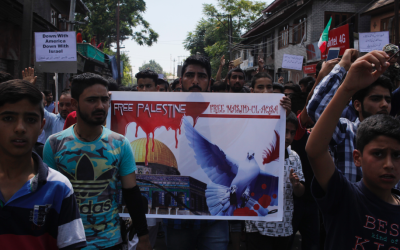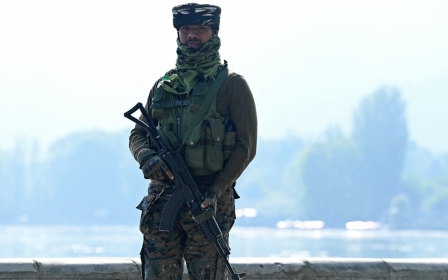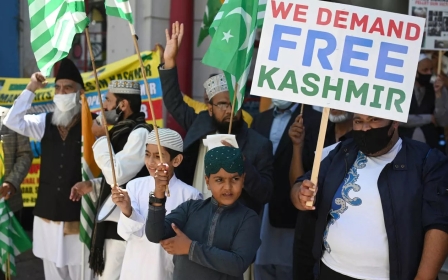How India is implementing the 'Israel model' in Kashmir

This past Sunday, Indian right-wing political commentator Anand Ranganathan called for an “Israel-like” solution in Kashmir, telling a podcast host: “Israel has catered for its people who were hard done by. We haven’t; it’s as simple as that. Despite that, yes, there may never be a solution because of the ideology of the people who hate Israelis, and the ideology of the people who hate Hindus.”
The clip went viral on social media. Horrified by the mention of an “Israel-like” solution amid the ongoing genocide in Gaza, many decried the remarks as a clear call for genocide against Muslims in Kashmir.
Ranganathan replied on X (formerly Twitter) that he was not calling for genocide, but rather to prevent another genocide by “rehabilitating the victims, making settlements, fighting terror, securing borders”.
The victims he was referencing are the Kashmiri Pandits, Kashmir’s minority Hindu population, a vast majority of whom (around 100,000) left the valley in the 1990s under conditions that have been deeply contested.
Some right-wing political commentators in India and the diaspora falsely refer to the tragic departure of Pandits from the valley as a “genocide”, weaponising their experiences to further demonise Kashmir’s Muslim-majority population, which has been demanding self-determination for decades. They see the steps taken by the Indian government in recent years to fully annex the territory as necessary to bring justice to the victims and end “terrorism”.
New MEE newsletter: Jerusalem Dispatch
Sign up to get the latest insights and analysis on Israel-Palestine, alongside Turkey Unpacked and other MEE newsletters
This is not the first time an Indian political or media personality has called for the Israeli model to be implemented in Kashmir.
In November 2019, just months after the Indian government removed Kashmir’s semi-autonomous status, the Indian consul general in New York City, Sandeep Chakravorty, said India would build settlements modelled after Israel for the return of the Hindu population to Kashmir.
Settler-colonial projects
Ranganathan’s comments have been criticised by many in India’s liberal left who oppose the US-backed Israeli genocide in Gaza and certainly do not want their country - which recently gave a third, albeit less enthusiastic, mandate to the Hindu nationalist prime minister, Narendra Modi - to be compared with Israel.
Many have also sought to differentiate the struggles in Kashmir and Palestine. “Those who liken Kashmir to Palestine, mostly the hard right and Islamists, understand neither the Kashmir dispute nor the Palestine question,” Stanly Johny, foreign affairs editor for The Hindu, wrote on X.
Some Indian leftists who are sympathetic to the Palestinian cause simply refuse to acknowledge the similarities between the settler-colonial projects of Israel and India. For them, Palestinians are engaged in a legitimate struggle against Israeli settler-colonialism, while Kashmir is one of two things: a territorial dispute between India and Pakistan, in which the latter has backed “terrorists” and “separatists”, or a domestic law-and-order problem involving a handful of unruly Kashmiri elements.
Amid the rise of Hindu nationalism in India, long gone is the benevolent discourse of inclusion; this ideology explicitly calls for demographic change
The more sympathetic of them will acknowledge that India must deal more constructively with Kashmiris, while still maintaining that Kashmir is an “integral” part of India.
To be sure, Kashmir and Palestine are not identical, nor are any other two global regions. But their struggles share a common source: British colonisation.
In Palestine, this resulted in the Balfour Declaration of 1917, which promised a “national home for the Jewish people” on Palestinian lands. In Kashmir, under the 1846 Treaty of Amritsar, the British sold the territory to a Hindu warlord from Jammu, resulting in the brutal suppression of the Muslim-majority population.
The freedom struggle in both contexts predated the monumental events of 1947-48, when both regions were subject to a partition, although there were significant differences between the two. The UN partition plan in Palestine affirmed Israeli settler-colonialism, while the partition of the Indian subcontinent resulted from the inability of the two primary parties in British India to agree on power-sharing after the departure of the British.
Displacement and ethnic cleansing
The “births” of India and Israel also meant the displacement and ethnic cleansing of Palestinians through the Nakba and Kashmiris through the Jammu massacre. After the first India-Pakistan war, the territory of Kashmir was divided between the two new nation-states.
Palestine and Kashmir were among the earliest issues debated in the newly formed United Nations, subject to the whims and failures of the liberal international order.
The UN called for a plebiscite to be held in the entirety of Kashmir, which India did not allow; this has defined the movement for self-determination for nearly eight decades. India’s subsequent rule in Kashmir has been managed through client regimes, such as the National Conference and the People’s Democratic Party - who, like their Palestinian Authority counterparts, effectively subcontract the colonial project.
Whereas the Israeli colonial project has been identified as such, especially in progressive and leftist circles, there is less awareness about India’s rule in Kashmir.
This is due to broader geopolitics, where for decades, India has presented itself as a vanguard of the anti-colonial world; but also because of India’s soft power, which seeks to project a violent, majoritarian state as non-violent, diverse, and the “world’s largest democracy”, incapable of subjugating an entire population against their will.
In some ways, then, the liberal left is correct that India is not Israel. This is because India has done a much better job of masking its colonial occupation and war crimes in Kashmir. But fundamentally, for both states, the anxieties are demographic.
For Israel, the presence of Palestinians poses a “demographic time bomb” for the “Jewish state” and must be dealt with. For India, the presence of Kashmiri Muslims, a demographic majority that has fiercely contested Indian sovereignty, must be replaced by Hindus for India to fully assert its rule.
Chilling reminder
Beyond attempting to untangle the two movements, there is another problem with the liberal left discourse: The Israel model is already being implemented in Kashmir. The longstanding relationship between India and Israel goes beyond military ties and shared tactics of suppression, to also include ideological links between Zionism and Hindutva, including in the diaspora.
Fundamentally, this model, utilised by other (settler-)colonial powers historically and at present, seeks to suppress liberation movements, replace indigenous communities, grab land, and erase history. While brandishing its liberal, democratic, secular credentials, it labels people’s movements as “terrorism”, and portrays victims as perpetrators. It gives complete authority for the state to do as it wishes to crush dissent, overlooking all norms of international law.
In Kashmir, the Israel model has not happened just since 2019, when India revoked Kashmir’s semi-autonomous status. The Indian National Congress, known as the “secular” party in India, deployed elements of this model while forcibly trying to “integrate” Kashmiri Muslims after 1947.
In my research, I argue that for many decades, this happened through development or empowerment, or the politics of life - a strategy that the Israeli government also used in the occupied West Bank and Gaza after the 1967 war. When that failed in the late 1980s after it was met with armed resistance and mass popular mobilisation for freedom in Kashmir, the Indian government used counter-revolutionary tactics similar to Israel’s.
These included massacres, torture, sexual violence, preventive detention, extrajudicial killings and home demolitions, to name just a few. Indian forces have trained with the Israeli army to learn how to suppress popular movements.
Amid the rise of Hindu nationalism in India, long gone is the benevolent discourse of inclusion; this ideology explicitly calls for demographic change and the building of Hindu settlements in Kashmir.
Given what Israel has been able to get away with in Gaza, Kashmiri Muslims know that the genocidal discourses they are repeatedly subjected to could also be actualised. Elements of the Israeli model are also used against Muslims across India, through regular lynchings and calls for genocide, the bulldozing of Muslim homes, and the passing of discriminatory laws.
Reading recent reports of the horrific use of sexual violence against Palestinian detainees in Israeli jails, including the insertion of metal rods in the anus, I was chillingly reminded of this exact type of abuse used against Kashmiris in Indian jails. Indeed, the India-Israel model seeks to strip away human dignity in all its forms.
The views expressed in this article belong to the author and do not necessarily reflect the editorial policy of Middle East Eye.
Middle East Eye delivers independent and unrivalled coverage and analysis of the Middle East, North Africa and beyond. To learn more about republishing this content and the associated fees, please fill out this form. More about MEE can be found here.







